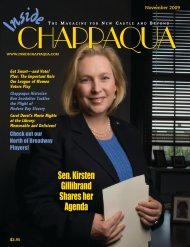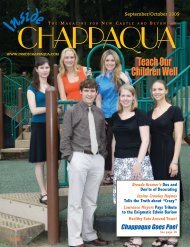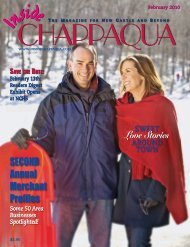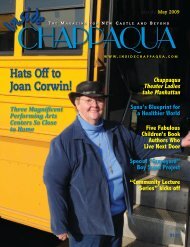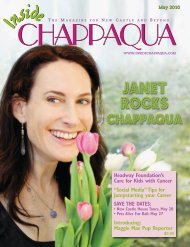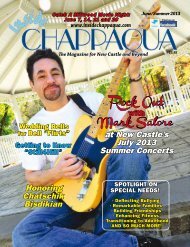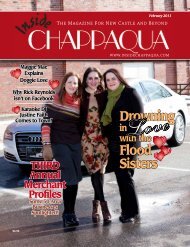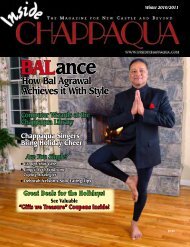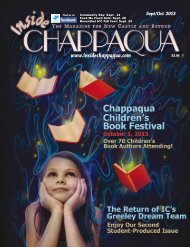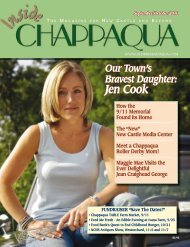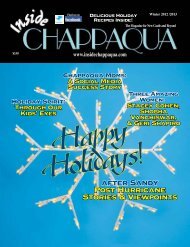download the May 2011 issue (PDF). - Inside Chappaqua
download the May 2011 issue (PDF). - Inside Chappaqua
download the May 2011 issue (PDF). - Inside Chappaqua
You also want an ePaper? Increase the reach of your titles
YUMPU automatically turns print PDFs into web optimized ePapers that Google loves.
TARP Initiative Spells S-U-C-C-E-S-S<br />
What do three teachers–Alissa<br />
Stoever, Lilli Ross, and Paul Bianchi–beside<br />
different subjects and<br />
grade levels, have in common?<br />
In a word: TARP, short for<br />
“Teacher Action Research Project,”<br />
a cutting-edge program that Dr.<br />
Lyn McKay, newly elected Superintendent<br />
of Schools, initiated when<br />
she was Assistant Superintendent<br />
for Curriculum and Instruction as<br />
a way of engaging teachers in educational<br />
research projects. Three<br />
teachers explained why TARP is<br />
quickly proving to be <strong>the</strong> “killer<br />
app” for educational progress on<br />
a practical level…<br />
Supercharging <strong>the</strong> Classroom<br />
In keeping with <strong>the</strong> “lifelong<br />
learning” mantra characterizing<br />
<strong>the</strong> award-winning <strong>Chappaqua</strong><br />
School District, teachers selected<br />
for <strong>the</strong> TARP program, now in its<br />
third year of operation, create a<br />
research question <strong>the</strong>y answer in<br />
<strong>the</strong>ir classrooms.<br />
Alissa Stoever, a kindergarten<br />
teacher for four years at West<br />
Orchard School, says TARP allowed<br />
her to consider new ways of improving<br />
her teaching: “My students<br />
were blossoming and growing as<br />
learners and problem solvers,” but<br />
something was missing in Playland.<br />
22 <strong>Inside</strong> <strong>Chappaqua</strong> <strong>May</strong> <strong>2011</strong><br />
By: Vicki de Vries<br />
During <strong>the</strong>ir<br />
unstructured,<br />
40-minute<br />
playtime, her<br />
typically curious<br />
five year olds<br />
went back and<br />
forth from <strong>the</strong><br />
housekeeping<br />
center to <strong>the</strong><br />
block center to <strong>the</strong> writing center<br />
and so on in an aimless fashion.<br />
“Their maturity level and social<br />
interaction skills did not match up<br />
to <strong>the</strong>ir academic performance,”<br />
and students would switch centers<br />
as often as five times, or, on average,<br />
spend only eight minutes per<br />
center.<br />
This wasted time became <strong>the</strong><br />
focus of Stoever’s “action research”<br />
question “How can play time become<br />
more productive?” Designing<br />
a “workshop model” to help students<br />
develop <strong>the</strong>ir language and<br />
higher level thinking skills proved<br />
to be <strong>the</strong> answer. Students would<br />
sit on a carpet and listen as she<br />
explained a strategy for <strong>the</strong>m to<br />
consider using during play time.<br />
One successful strategy utilized<br />
<strong>the</strong> simple rhyme “When you think<br />
you’re done, you’ve only just begun,”<br />
which <strong>the</strong> class used in <strong>the</strong>ir<br />
writing center. “It was as if a light<br />
bulb went on when <strong>the</strong>y applied<br />
this rhyme to what <strong>the</strong>y could do<br />
at <strong>the</strong> centers,” said Stoever, who<br />
collected data to track how many<br />
times students were changing centers.<br />
The results were remarkable.<br />
Many students were able to stay at<br />
<strong>the</strong> same center for an entire play<br />
period, while o<strong>the</strong>rs, for as long as<br />
a week.<br />
A Great Learning Experience<br />
“Some things I did were not<br />
always highly successful, but I<br />
learned from <strong>the</strong>m,” said Lilli Ross,<br />
a 5th grade special education teacher<br />
at Seven Bridges School, where<br />
she provides collaborative support<br />
in math, reading, and writing and<br />
co-teaches math in a fully inclusive<br />
classroom. Ross’s first-year project<br />
focused on how to help special<br />
education students develop selfmanagement<br />
techniques. “I learned<br />
how resilient students are about<br />
learning new things,” said Ross.<br />
“What do powerful writers do?”<br />
became her new research question,<br />
which she answered by using<br />
a variety of approaches to connect<br />
basic writing skills with real-world<br />
events, including inviting a local<br />
journalist to speak. As a result, “my<br />
students began to see <strong>the</strong>mselves<br />
through a new lens,” said Ross.<br />
“Engaging in action research is<br />
rigorous and time consuming, but<br />
when you see <strong>the</strong> effect on <strong>the</strong> kids,<br />
it’s definitely worth it.”<br />
New Ways to Revitalize Teaching<br />
For Paul Bianchi, a physics teachers<br />
for 26 years, 13 at Horace Greeley<br />
High School, TARP has revitalized<br />
his teaching approach: “This is<br />
what most teaching will be like in<br />
10 years. Technology has made it<br />
possible to rethink what happens<br />
in <strong>the</strong> classroom.”<br />
Still in his first-year research<br />
project, Bianchi enjoys answering<br />
<strong>the</strong> question “How does making<br />
class notes available online affect<br />
student performance?” by daily<br />
posting his course notes on Blackboard,<br />
Greeley’s online software<br />
portal for class assignments and<br />
documents. “Students discuss<br />
online notes and solve physics<br />
problems in small groups, and I<br />
can spend more time helping <strong>the</strong><br />
students.”<br />
Bianchi is already planning for<br />
next year’s research question:<br />
“Where will I take this?” A likely<br />
answer may be linked to technology.<br />
Bianchi waxed philosophical:<br />
“It’s easy to lose a bit of idealism<br />
and <strong>the</strong> excitement that first attracted<br />
you to your work. TARP has<br />
made me feel a great deal of enthusiasm<br />
in my work.”<br />
Ano<strong>the</strong>r attractive feature of<br />
TARP is sharing research findings<br />
with o<strong>the</strong>r TARP participants and<br />
staff developers, who meet every<br />
six to eight weeks as a group. Core<br />
groups of three teachers from<br />
different grade levels meet every<br />
month. “It’s amazing how much<br />
cross-fertilization takes place,” said<br />
Ross, “and it’s contagious!”<br />
Vicki de Vries is a writer, editor and<br />
educator who thinks this TARP should<br />
be cloned.



